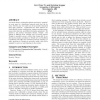945 search results - page 112 / 189 » On Equivalence Between Network Topologies |
CDC
2010
IEEE
13 years 2 months ago
2010
IEEE
Abstract-We study the well known linear consensus algorithm by means of a LQ-type performance cost. We want to understand how the communication topology influences this algorithm. ...
ICANN
2009
Springer
14 years 2 months ago
2009
Springer
Polychronization has been proposed as a possible way to investigate the notion of cell assemblies and to understand their role as memory supports for information coding. In a spiki...
AINA
2007
IEEE
14 years 2 months ago
2007
IEEE
The construction of multicast trees is complicated by the need to balance a number of important objectives, including: minimizing latencies, minimizing depth/hops, and bounding th...
MOBICOM
2005
ACM
14 years 1 months ago
2005
ACM
Vehicular Ad Hoc Networks (VANET) have several characteristics that distinguish them from other ad hoc networks. Among those is the rapid change in topology due to traffic jams, w...
CCS
2010
ACM
13 years 8 months ago
2010
ACM
A network latency estimation scheme associates a "position" to every peer in a distributed network such that the latency between any two nodes can be accurately estimate...

